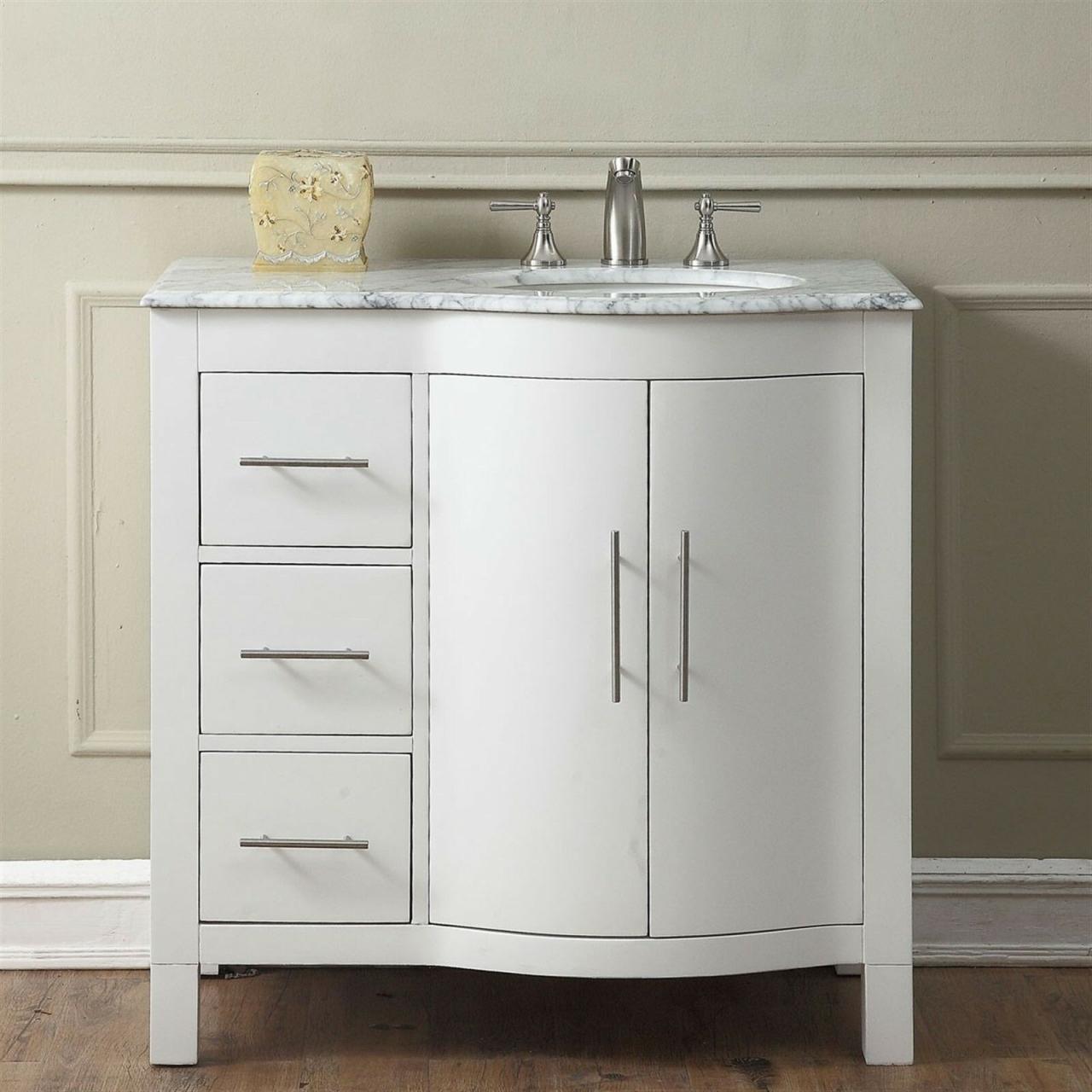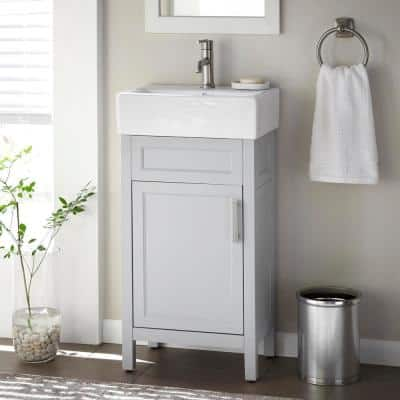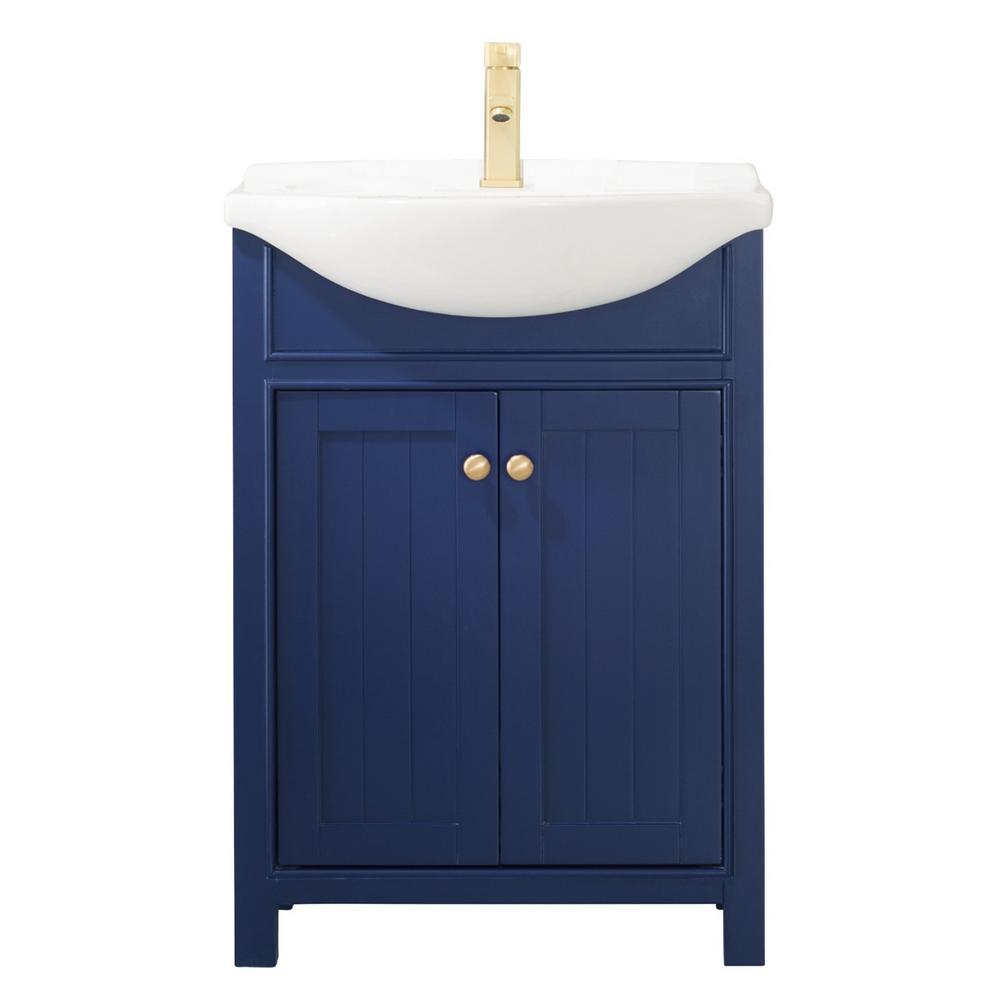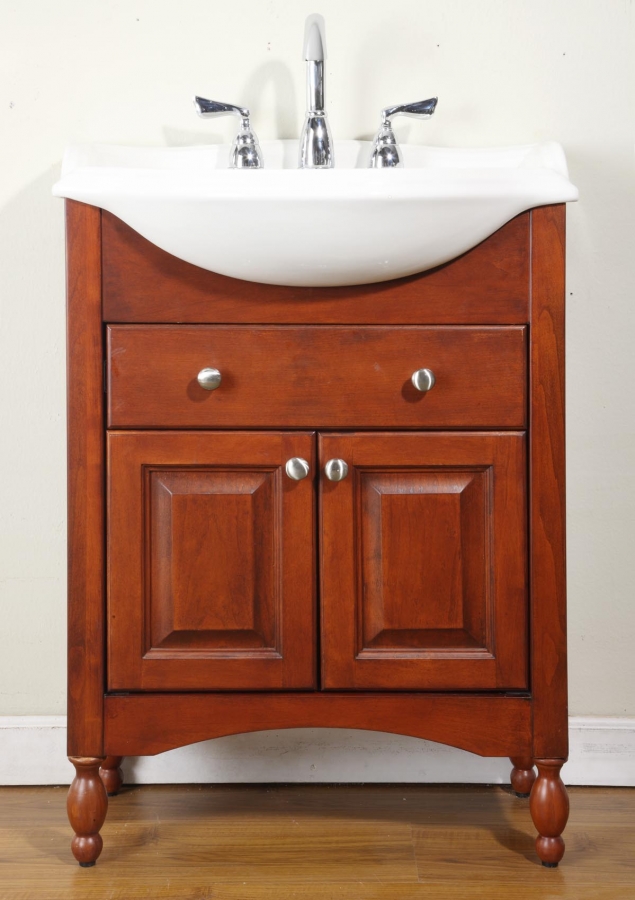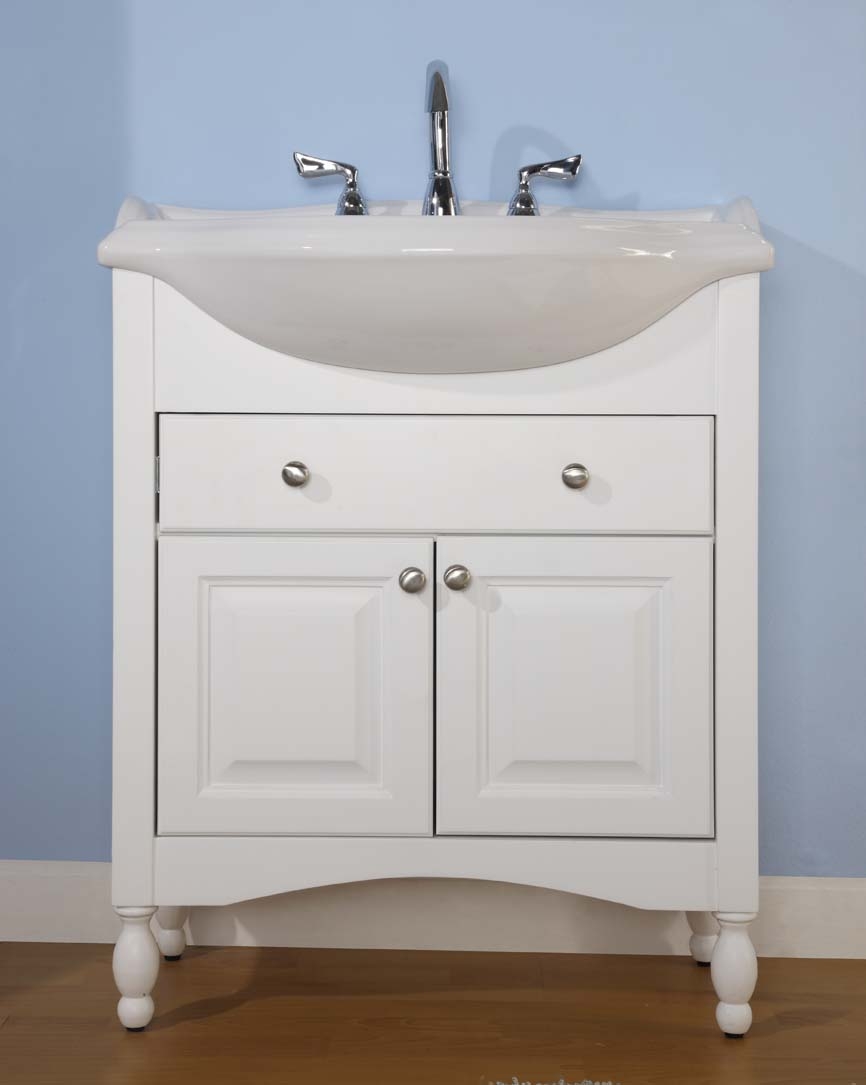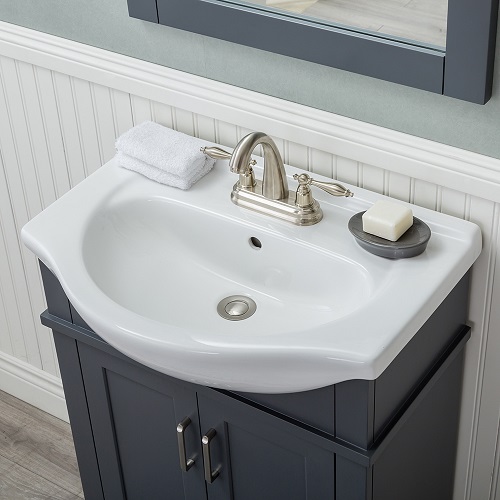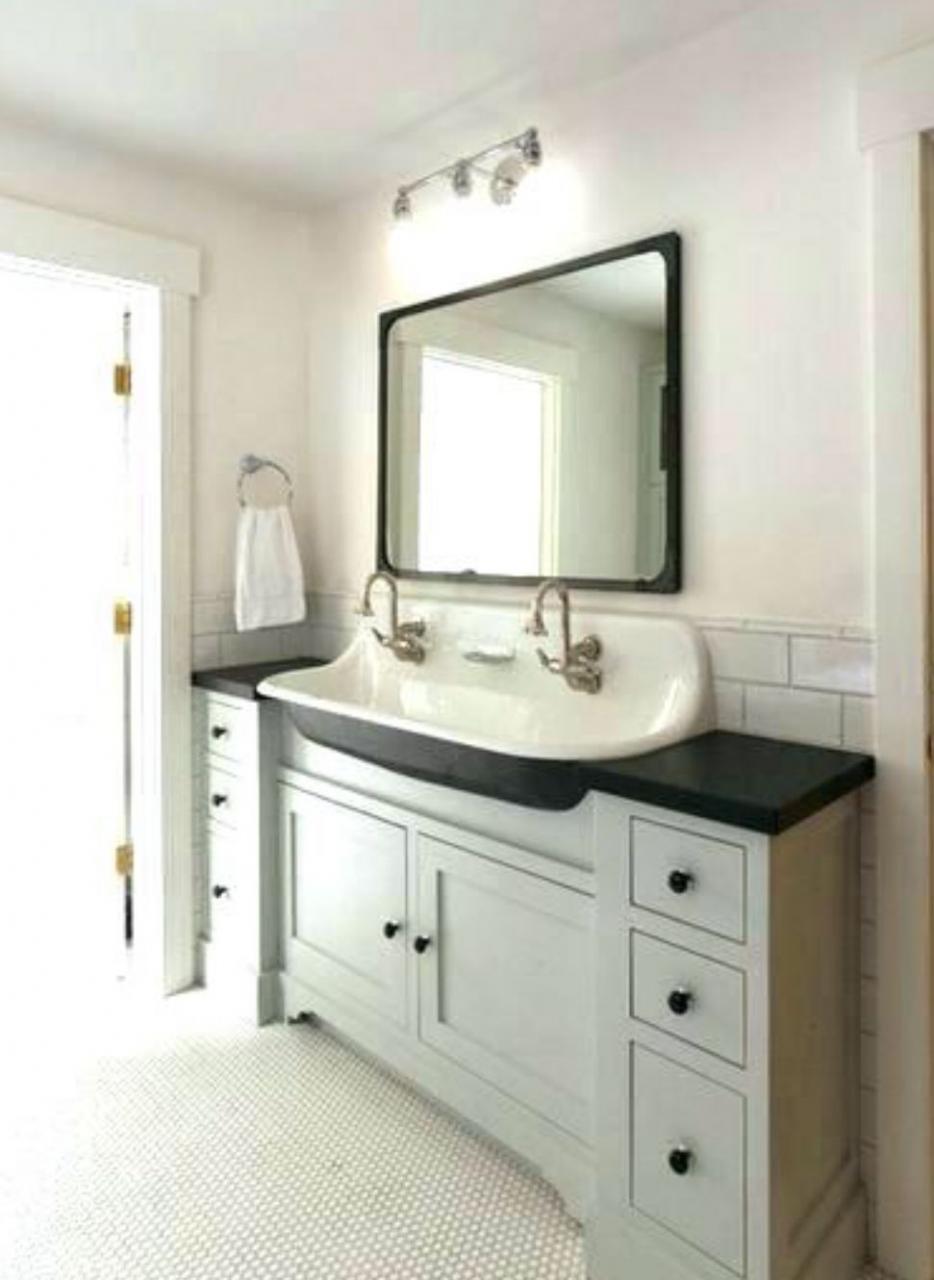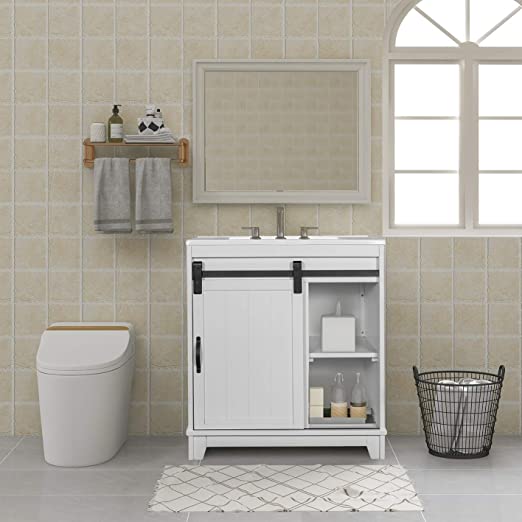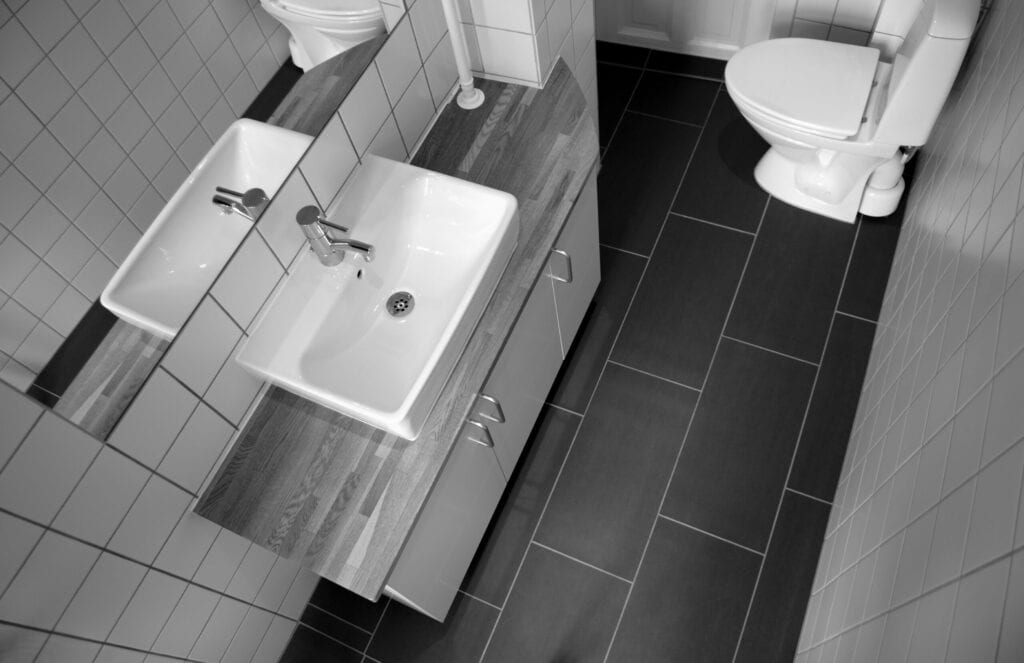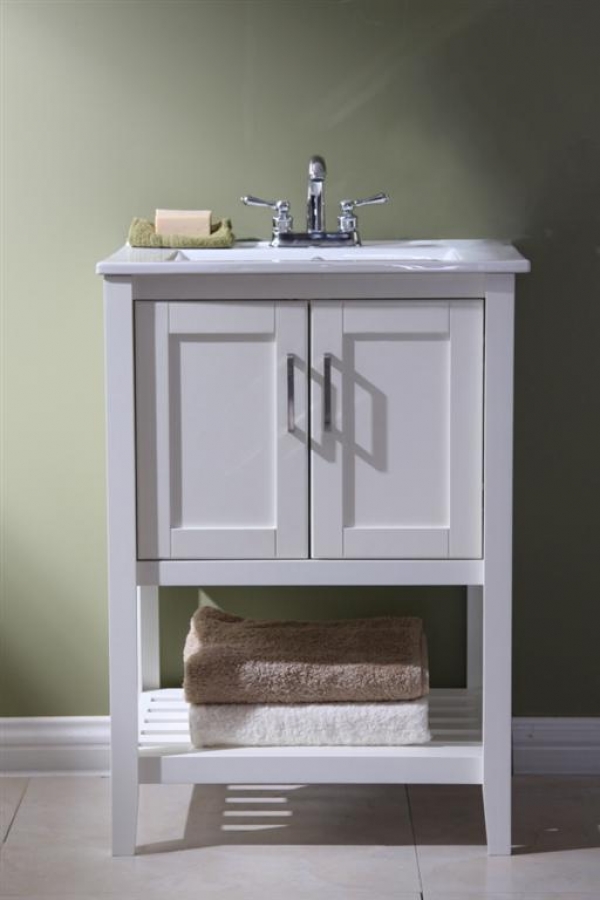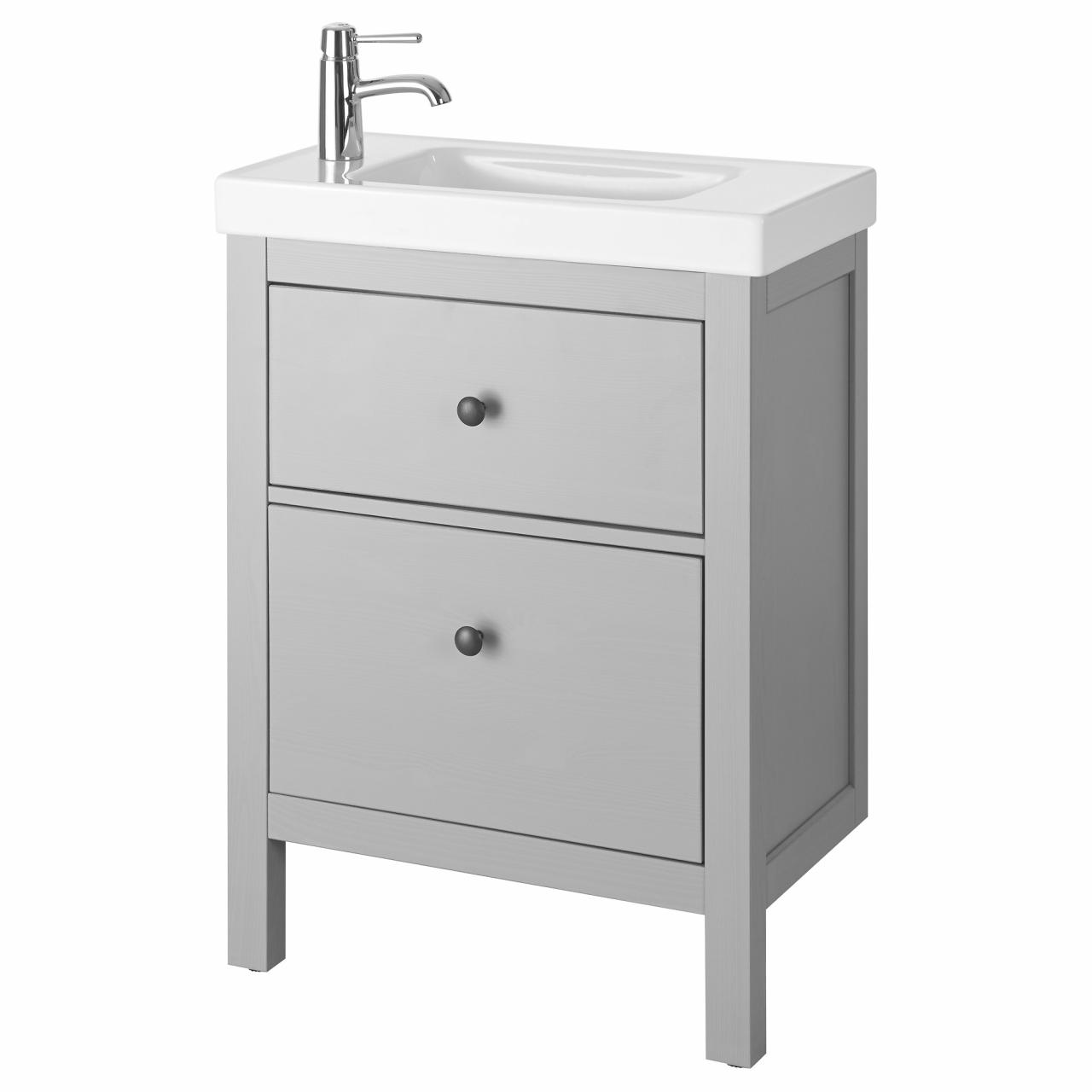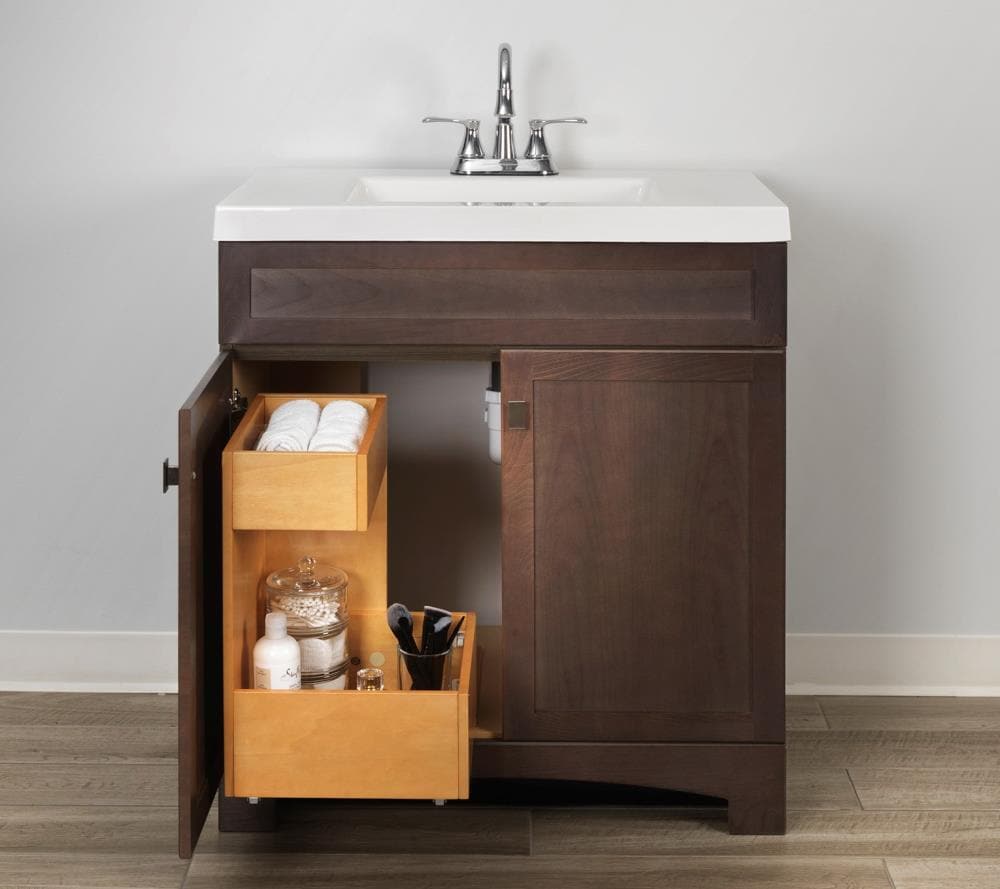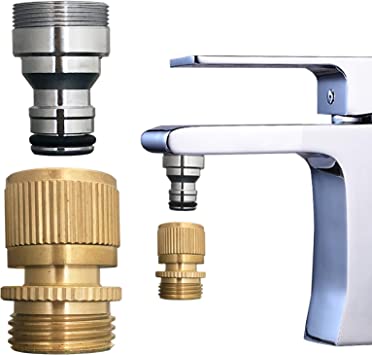Space-Saving Benefits of Narrow Bathroom Sink Vanities
In the world of bathroom design, maximizing space without sacrificing style or functionality is often a top priority, especially in smaller bathrooms or powder rooms. Narrow bathroom sink vanities have become a popular solution for homeowners looking to make the most out of limited space. These compact vanities offer a variety of benefits that can transform a cramped bathroom into a more comfortable and efficient space. Here’s a look at why narrow bathroom sink vanities are a smart choice for space-saving and how they can enhance your bathroom’s overall functionality and aesthetics.
- Maximizing Floor Space: One of the most significant advantages of narrow bathroom sink vanities is their ability to maximize floor space. In smaller bathrooms, every square inch counts, and a traditional, bulky vanity can make the room feel cramped and uncomfortable. Narrow vanities, often ranging from 12 to 24 inches in width, allow for more open floor space, making the bathroom appear larger and more open. This increased floor space can make the room easier to navigate, improving the overall flow and usability of the bathroom.
- Enhancing Bathroom Layout: Narrow sink vanities are versatile and can be integrated into various bathroom layouts, from long, narrow spaces to compact powder rooms. By choosing a narrow vanity, homeowners can optimize the bathroom layout, ensuring that fixtures and fittings are well-placed and functional. For example, a narrow vanity can be positioned to avoid obstructing door swings or to create a better flow between the sink, toilet, and shower. This adaptability makes narrow vanities a valuable addition to any small bathroom design.
- Creating a Clutter-Free Environment: A narrow vanity helps create a clutter-free environment, which is crucial for smaller bathrooms where space is at a premium. With a narrow sink vanity, there is less surface area to collect clutter, encouraging users to keep the space tidy and organized. Many narrow vanities also come with built-in storage options, such as drawers or shelves, which provide essential storage space for bathroom necessities while keeping them out of sight. This helps maintain a clean and streamlined look, contributing to a more relaxing and inviting bathroom atmosphere.
- Easy to Maintain and Clean: Another benefit of narrow bathroom sink vanities is that they are easier to maintain and clean compared to larger, more intricate vanities. With less surface area and fewer nooks and crannies, narrow vanities require less time and effort to clean, making them a practical choice for busy households. The streamlined design of narrow vanities also means that they are less likely to accumulate dust and grime, ensuring that the bathroom stays cleaner for longer.
- Adding Style without Overwhelming the Space: Narrow bathroom sink vanities come in a wide range of styles, from modern and minimalist to classic and traditional, allowing homeowners to add a touch of style to their bathroom without overwhelming the space. The compact size of narrow vanities means that they can complement the overall design of the bathroom without dominating it. Whether you prefer a sleek, contemporary look or a more rustic, vintage feel, there’s a narrow vanity that will fit your style and enhance the aesthetics of your bathroom.
- Affordable and Accessible Options: Narrow bathroom sink vanities are often more affordable than their larger counterparts, making them an attractive option for budget-conscious homeowners. The smaller size means less material is used, which can result in cost savings. Additionally, narrow vanities are widely available and come in a variety of price ranges, from budget-friendly options to high-end designs. This accessibility makes it easy for homeowners to find a narrow vanity that fits their budget and meets their design preferences.
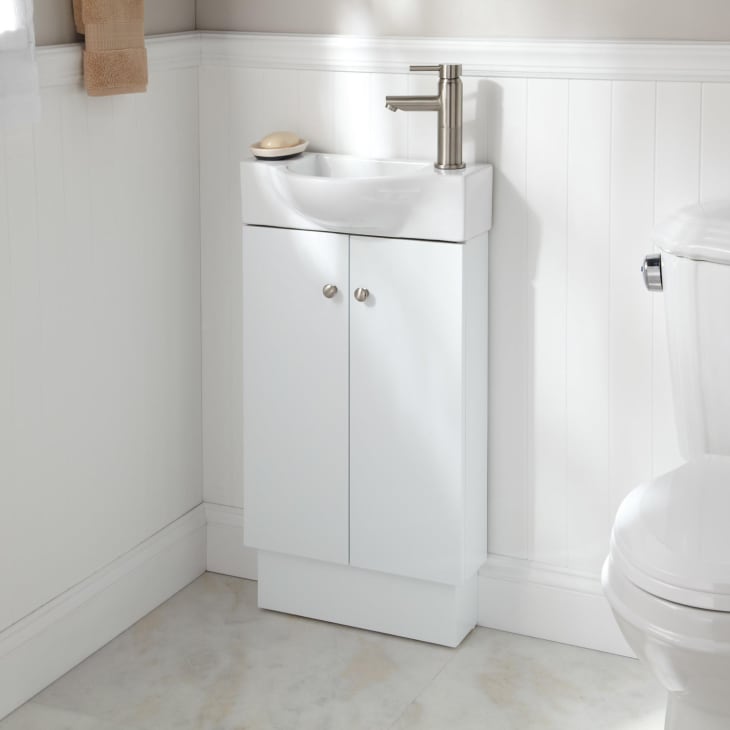
Choosing the Right Material for Your Narrow Vanity
When it comes to selecting a narrow bathroom sink vanity, the choice of material is a critical factor that can influence the vanity’s durability, appearance, and maintenance requirements. The right material can enhance the overall look of the bathroom, provide long-lasting performance, and meet the practical needs of the space. From natural wood to modern composites, there are several materials to consider for your narrow vanity. Here’s a guide to help you choose the best material for your bathroom needs.
Solid Wood: Timeless and Durable
Solid wood is a popular choice for bathroom vanities due to its timeless appeal and durability. Materials like oak, maple, and walnut offer a classic and sophisticated look that can suit both traditional and contemporary bathroom styles. Solid wood vanities are known for their strength and ability to withstand the rigors of daily use. However, it’s essential to ensure that the wood is properly sealed and treated to resist moisture and prevent warping, as bathrooms are high-humidity environments. With proper care, a solid wood vanity can last for many years and add warmth and character to the bathroom.
Engineered Wood: Cost-Effective and Versatile
Engineered wood, such as medium-density fiberboard (MDF) and plywood, is another common material for bathroom vanities. These materials are made by combining wood fibers or veneers with resins and adhesives, creating a stable and durable product. Engineered wood vanities are often more affordable than solid wood options, making them an attractive choice for budget-conscious homeowners. They are also available in a wide range of finishes, from natural wood grains to painted surfaces, allowing for greater design flexibility. However, it’s essential to choose high-quality engineered wood products that are moisture-resistant to prevent swelling or damage over time.
Laminate: Low Maintenance and Modern
Laminate is a synthetic material made by fusing layers of paper or fabric with resin under high pressure. It is often used as a surface layer on bathroom vanities to create a durable and easy-to-clean finish. Laminate vanities are available in various colors and patterns, including designs that mimic the look of natural wood, stone, or other materials. This makes laminate a versatile and affordable option for homeowners who want a modern and stylish look without the high cost of natural materials. Laminate surfaces are resistant to moisture and stains, making them a low-maintenance choice for busy bathrooms.
Metal: Industrial and Durable
Metal vanities, made from materials like stainless steel, brass, or aluminum, offer a sleek and modern look that is perfect for contemporary or industrial-style bathrooms. Metal is highly durable and resistant to moisture, making it an excellent choice for bathroom environments. Stainless steel, in particular, is resistant to rust and corrosion, ensuring that the vanity will maintain its appearance over time. Metal vanities can add a touch of sophistication and shine to the bathroom, creating a clean and streamlined aesthetic. However, they may require regular cleaning to prevent water spots and fingerprints.
Stone: Luxurious and Elegant
Natural stone, such as marble, granite, or quartz, is a luxurious material that can add elegance and sophistication to a bathroom vanity. Stone vanities offer a unique and timeless look, with each piece of stone featuring its distinct veining and patterns. Stone is highly durable and resistant to scratches and heat, making it a long-lasting option for bathroom vanities. However, natural stone can be porous and may require sealing to prevent staining and moisture absorption. Stone vanities are often more expensive than other materials, but they can add significant value and beauty to the bathroom.
Glass: Sleek and Contemporary
Glass vanities offer a sleek and contemporary look that can make a small bathroom feel more open and airy. Tempered glass is used for bathroom vanities because it is strong, durable, and resistant to scratches and breakage. Glass vanities are available in various colors and finishes, including frosted, clear, or tinted options, allowing homeowners to customize the look to suit their design preferences. Glass surfaces are easy to clean and maintain, making them a practical choice for modern bathrooms. However, they may require regular cleaning to prevent water spots and streaks.
Stylish Designs for Narrow Bathroom Sink Vanities
Narrow bathroom sink vanities are not just practical solutions for small spaces; they can also be stylish focal points that enhance the overall design of the bathroom. With a wide range of styles and designs available, narrow vanities can cater to different tastes and preferences, from minimalist modern to classic traditional. Here are some stylish design options for narrow bathroom sink vanities that can add both functionality and aesthetic appeal to your bathroom.
Sleek and Minimalist Designs
For those who prefer a clean and modern look, sleek and minimalist vanities are an excellent choice. These vanities often feature simple, straight lines and a lack of ornate details, creating a streamlined and uncluttered appearance. Minimalist vanities are usually finished in neutral colors like white, black, or gray, which can complement various bathroom color schemes. The use of high-gloss finishes or materials like glass and stainless steel can add a touch of sophistication and shine, making the bathroom feel more open and airy. This style is perfect for those who want a contemporary and elegant bathroom design.
Classic and Traditional Styles
Narrow vanities with classic and traditional designs can add a touch of elegance and timeless appeal to the bathroom. These vanities often feature decorative elements like paneled doors, ornate hardware, and curved legs. Rich wood finishes, such as cherry, mahogany, or walnut, are commonly used to enhance the classic look. Traditional vanities can create a warm and inviting atmosphere, making the bathroom feel more like a cozy retreat. This style is ideal for homeowners who appreciate a more formal and sophisticated aesthetic in their bathroom.
Rustic and Farmhouse Designs
Rustic and farmhouse-style vanities are perfect for those who want to create a cozy and charming bathroom. These vanities often feature natural wood finishes, distressed details, and vintage-inspired hardware, adding character and personality to the space. Reclaimed wood or weathered finishes can create a rustic, lived-in look that feels warm and inviting. Farmhouse vanities may also include open shelving or barn-style doors, adding to the rustic appeal. This style is ideal for those who want to bring a touch of country charm to their bathroom.
Floating Vanities
Floating vanities are a stylish and modern option that can make a narrow bathroom feel more spacious. These vanities are mounted on the wall, creating the illusion of more floor space and making the bathroom feel less cluttered. Floating vanities often feature clean lines and minimalist designs, which can complement various bathroom styles. They also offer the added benefit of easy cleaning underneath, as there are no legs or bases to navigate around. This design is perfect for contemporary bathrooms that want to maintain a sleek and open look.
Integrated Sink Vanities
Integrated sink vanities combine the sink and countertop into a single, seamless unit, creating a sleek and modern look. These vanities often feature a solid surface material like quartz or acrylic, which is easy to clean and maintain. The integrated sink design eliminates the need for separate sink and countertop pieces, resulting in a streamlined and cohesive appearance. This style is ideal for those who want a minimalist and contemporary look with a focus on simplicity and functionality.
Multi-Functional Vanities
Narrow vanities with multi-functional designs can provide additional features that enhance the bathroom’s usability. These vanities may include built-in storage solutions, such as drawers or shelves, as well as integrated lighting or mirrors. Some designs even feature folding or extendable elements that can be adjusted to meet various needs. Multi-functional vanities are perfect for small bathrooms where every inch of space matters, as they offer practical solutions without compromising on style.
Incorporating Storage Solutions in a Narrow Vanity
In a narrow bathroom, efficient use of space is essential, and incorporating smart storage solutions into a narrow vanity can significantly enhance the functionality of the space. While narrow vanities may have limited surface area, there are various ways to maximize storage and keep the bathroom organized. Here are some effective storage solutions for narrow bathroom sink vanities that can help you make the most of your available space.
Built-In Drawers and Cabinets
Many narrow vanities come with built-in drawers and cabinets that provide essential storage space for bathroom necessities. Drawers are ideal for storing smaller items like toiletries, makeup, and grooming supplies, while cabinets can house larger items such as cleaning products and extra towels. Look for vanities with adjustable or removable shelves to customize the storage space according to your needs. The addition of soft-close hinges or full-extension drawer slides can enhance the functionality and convenience of the vanity.
Open Shelving
Open shelving is a popular storage solution for narrow vanities, as it provides easy access to frequently used items while keeping them within reach. Open shelves can be incorporated into the design of the vanity or added as a separate feature above or beside the vanity. Use baskets, bins, or decorative boxes to organize and conceal smaller items on the shelves, creating a tidy and visually appealing display. Open shelving also helps to keep the bathroom feeling more open and airy, as it does not add bulk or visual weight to the space.
Pull-Out and Pull-Down Features
Pull-out and pull-down storage features can be highly effective in narrow vanities, as they allow you to access items that are stored in tight spaces. Pull-out shelves or trays can be installed within the vanity to provide easy access to items at the back of the cabinet. Pull-down racks or baskets can be mounted inside cabinet doors or above the vanity to hold items like hairdryers or cleaning supplies. These features maximize storage efficiency and make it easier to keep the bathroom organized.
Vertical Storage Solutions
In a narrow bathroom, vertical storage solutions can help to make the most of available space. Consider installing vertical cabinets or tall storage units alongside the vanity to provide additional storage without taking up extra floor space. Vertical storage can also be incorporated into the vanity design itself, with tall, narrow cabinets or stacked drawers that make use of the vertical space above the sink. This approach helps to keep the bathroom organized and provides ample storage for various items.
Customizable Organizers
Customizable organizers can enhance the functionality of narrow vanities by allowing you to tailor the storage to your specific needs. Drawer dividers, tray organizers, and pull-out bins can be used to separate and organize items within the vanity drawers and cabinets. These organizers help to keep items in place and make it easier to find what you need quickly. Customizable organizers are available in various sizes and configurations, making it easy to create a storage solution that works for your bathroom.
Mirrored Cabinets
Mirrored cabinets are a stylish and practical storage solution for narrow vanities. These cabinets feature a mirrored front that reflects light and helps to make the bathroom feel more spacious. Inside, the cabinets provide storage for toiletries, medications, and other essentials. Mirrored cabinets are available in various sizes and styles, from single-door to double-door configurations, allowing you to choose the option that best fits your bathroom’s needs and design.
Selecting the Perfect Sink for Your Narrow Vanity
Choosing the right sink for a narrow bathroom vanity is crucial for ensuring that the space remains functional and stylish. The sink must complement the vanity’s design while providing adequate functionality for daily use. With various sink options available, it’s essential to consider factors such as size, shape, and material to find the perfect fit for your narrow vanity. Here’s a guide to help you select the ideal sink for your narrow bathroom vanity.
Pedestal Sinks
Pedestal sinks are a classic option for narrow bathroom vanities, offering a space-saving design that works well in compact spaces. The pedestal supports the sink while leaving the floor area open, making the bathroom feel more spacious. Pedestal sinks come in various styles, from traditional to modern, and are available in different materials such as porcelain or ceramic. While pedestal sinks provide minimal storage space, they are an excellent choice for bathrooms where maximizing floor space is a priority.
Wall-Mounted Sinks
Wall-mounted sinks are another space-saving option for narrow vanities. These sinks are attached directly to the wall, leaving the floor area open and creating a clean, modern look. Wall-mounted sinks are available in various sizes and shapes, making it easy to find one that fits your narrow vanity. They also offer the advantage of easy cleaning underneath, as there are no legs or pedestals to navigate around. However, it’s important to ensure that the wall can support the weight of the sink and plumbing.
Undermount Sinks
Undermount sinks are installed beneath the countertop, creating a seamless and sleek appearance. These sinks are a great choice for narrow vanities with solid surface countertops, such as granite or quartz. The undermount design eliminates the need for a visible sink rim, providing a clean and modern look. Additionally, undermount sinks make it easier to wipe debris directly into the sink, contributing to a more streamlined and functional bathroom design.
Vessel Sinks
Vessel sinks sit on top of the vanity countertop, creating a visually striking focal point. These sinks come in various shapes and materials, including glass, ceramic, and stone. Vessel sinks are ideal for narrow vanities with ample countertop space, as they can add a touch of elegance and style to the bathroom. However, it’s important to consider the height of the sink and ensure that it is comfortable to use, as vessel sinks can be higher than traditional sinks.
Corner Sinks
Corner sinks are specifically designed to fit into the corner of a narrow bathroom, making efficient use of available space. These sinks are a practical solution for small bathrooms where traditional sink placements may not be feasible. Corner sinks come in various styles and materials, allowing you to choose one that complements your narrow vanity. They are an excellent choice for maximizing floor space and creating a functional and stylish bathroom layout.
Integrated Sink and Vanity Combos
Integrated sink and vanity combos offer a seamless and coordinated look, with the sink and vanity designed as a single unit. These combos are available in various sizes and styles, making them a versatile option for narrow vanities. Integrated sinks often feature built-in storage solutions and countertops, providing a practical and stylish solution for small bathrooms. This design option helps to create a cohesive and streamlined appearance, making the bathroom feel more organized and well-designed.
Installation Tips for Narrow Bathroom Sink Vanities
Installing a narrow bathroom sink vanity requires careful planning and execution to ensure that the vanity fits properly and functions effectively in the space. Proper installation is essential for achieving a professional-looking finish and ensuring that the vanity performs well over time. Here are some essential installation tips for narrow bathroom sink vanities to help you achieve a successful and hassle-free installation.
Measure the Space Accurately
Before purchasing and installing a narrow vanity, it’s crucial to measure the space accurately. Measure the width, depth, and height of the area where the vanity will be installed, as well as the location of any existing plumbing. This will help you choose a vanity that fits perfectly in the space and ensures that there are no issues with plumbing connections. Use a tape measure and level to double-check your measurements and ensure that the vanity will be aligned correctly.
Prepare the Plumbing
Ensure that the plumbing is properly prepared before installing the vanity. If you are replacing an existing vanity, turn off the water supply and disconnect the plumbing connections. If you are installing a new vanity, make sure that the water supply and drain lines are correctly positioned and accessible. It may be necessary to adjust the plumbing or install new connections to accommodate the narrow vanity. Consider hiring a professional plumber if you are unsure about making plumbing modifications.
Secure the Vanity to the Wall
For a secure and stable installation, it’s important to properly anchor the vanity to the wall. Use wall anchors or screws to attach the vanity to the studs in the wall, ensuring that it is level and firmly secured. If you are installing a floating vanity, make sure that the wall can support the weight of the vanity and sink. Use a level to ensure that the vanity is installed straight and adjust as needed before securing it in place.
Install the Sink and Countertop
Once the vanity is secured, proceed with installing the sink and countertop. For undermount sinks, apply a bead of silicone caulk around the sink’s edge before placing it under the countertop. Ensure that the sink is properly aligned and sealed to prevent leaks. For vessel sinks, follow the manufacturer’s instructions for mounting the sink on the countertop and securing it in place. Make sure that all connections are tightly sealed to avoid any water leakage.
Connect the Plumbing
After the sink and countertop are installed, reconnect the plumbing to the sink. Ensure that all connections are secure and check for any leaks. Turn on the water supply and test the sink to ensure that it is functioning properly. Make any necessary adjustments to the plumbing connections to ensure a proper fit and prevent leaks. It’s a good idea to check for leaks periodically after installation to ensure that everything is working correctly.
Finishing Touches
Complete the installation by adding any finishing touches to the vanity. Install cabinet handles or knobs, if applicable, and check that all doors and drawers are properly aligned and functioning smoothly. Clean the vanity and countertop to remove any dust or debris from the installation process. Consider adding decorative elements, such as a mirror or wall-mounted shelves, to enhance the overall look of the bathroom and complement the narrow vanity.
Maintaining and Cleaning Your Narrow Bathroom Sink Vanity
Proper maintenance and cleaning of your narrow bathroom sink vanity are essential for keeping it looking its best and ensuring its longevity. Regular care can prevent damage, maintain the vanity’s appearance, and ensure that it functions effectively over time. Here’s a guide to help you maintain and clean your narrow bathroom sink vanity, keeping it in top condition.
Clean the Vanity Regularly
To keep your narrow bathroom sink vanity looking clean and fresh, it’s important to clean it regularly. Use a mild, non-abrasive cleaner and a soft cloth or sponge to wipe down the surfaces of the vanity, including the countertop, sink, and any cabinetry. Avoid using harsh chemicals or abrasive cleaners that can damage the finish or surface of the vanity. For glass or mirrored surfaces, use a glass cleaner or a mixture of water and vinegar to achieve a streak-free shine.
Wipe Down the Sink After Each Use
To prevent stains and soap scum buildup, make a habit of wiping down the sink after each use. Use a soft cloth or sponge to remove any water spots, toothpaste, or other residues from the sink and faucet. This simple step helps to keep the sink looking clean and reduces the need for more intensive cleaning later on. Pay special attention to areas around the faucet and drain where water can accumulate.
Check for Leaks and Repair Promptly
Regularly inspect the plumbing connections and sink for any signs of leaks or water damage. If you notice any leaks, address them promptly to prevent water damage to the vanity and surrounding areas. Tighten any loose connections and replace worn or damaged seals as needed. If you are unable to resolve a leak on your own, consider hiring a professional plumber to ensure that the issue is properly fixed.
Protect the Finish
To maintain the appearance of your vanity, protect the finish from potential damage. Avoid placing hot objects, such as curling irons or hairdryers, directly on the vanity surface, as this can cause burns or discoloration. Use coasters or trays under items to prevent scratches or stains. For wooden vanities, consider applying a protective sealant or polish periodically to maintain the wood’s luster and prevent damage.
Address Stains and Spills Promptly
If spills or stains occur, address them promptly to prevent them from setting in. For spills on the countertop or sink, wipe them up immediately with a damp cloth and mild cleaner. For stubborn stains, use a specialized cleaner designed for the material of your vanity, following the manufacturer’s instructions. Avoid using abrasive scrubbing pads or harsh chemicals that can damage the surface.
Maintain Proper Ventilation
Ensure that your bathroom has proper ventilation to prevent excess moisture and humidity, which can lead to mold and mildew growth. Use an exhaust fan or open a window to keep the bathroom well-ventilated, especially after showers or baths. Proper ventilation helps to maintain the condition of your vanity and prevents moisture-related issues that can affect its appearance and functionality.
Long and narrow bathroom vanity
Bathroom Sink Vanity
Small Bathroom Vanities that Take Back Your Space
24 Inch Narrow Bathroom Vanity Open Shelf in White
Small Bathroom Vanities and Sinks for Tiny Spaces
Related Posts:
